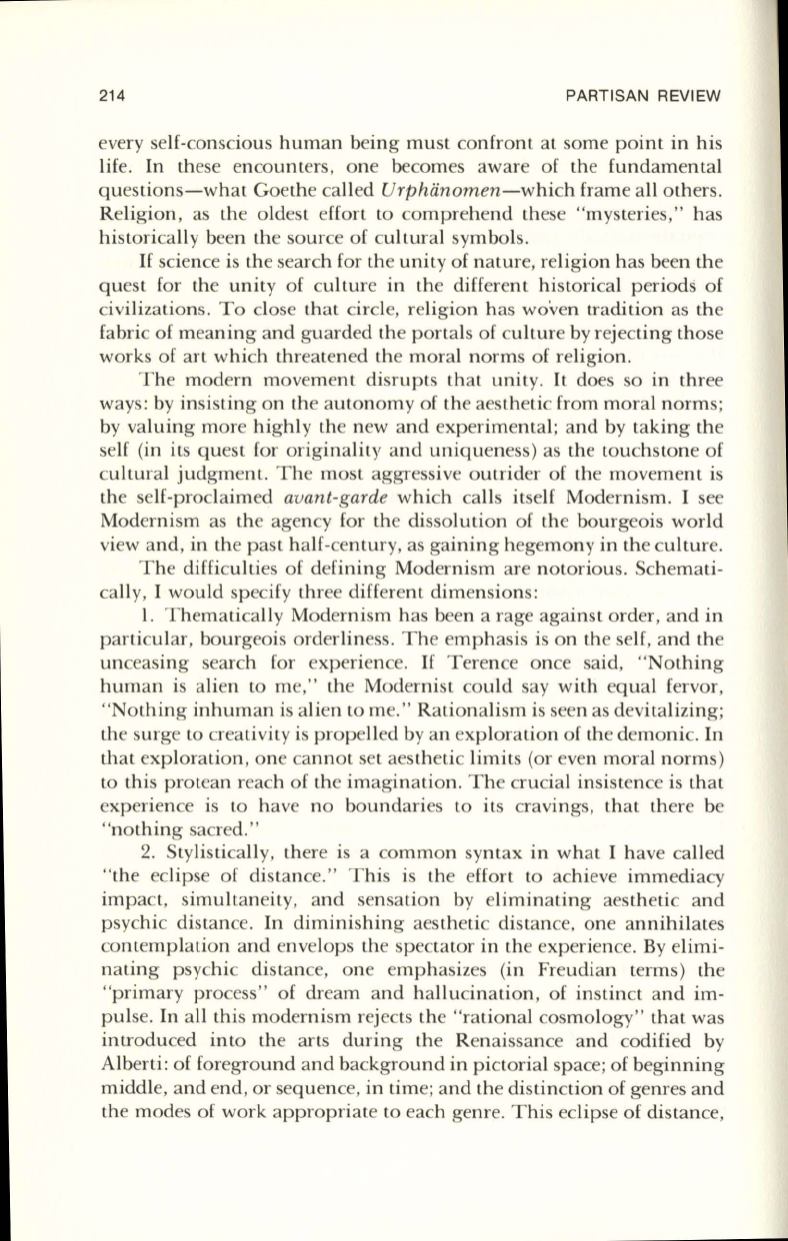
214
PARTISAN REVIEW
every self-conscious human being must confront at some point in his
life. In these encounters, one becomes aware of the fundamental
questions-what Goethe called
Urphiinomen-which
frame all others.
Religion , as the oldest effort to comprehend these "mysteries," has
historically been the source of cultural symbols.
1£
science is the search for the unity of nature, religion has been the
quest for the unity of culture in the different historical periods of
civilizations. To close that circle, religion has woven tradition as the
fabric of meaning and guarded the portals of culture by rejecting those
works of art which threatened the moral norms of religion.
The modern movement disrupts that unity.
It
does so in three
ways: by insisting on the autonomy of the aesthetic from moral norms;
by valuing more highly the new and experimental; and by taking the
self (in its quest for originality and uniqueness) as the touchstone of
cultural judgment. The most aggressive outrider of the movement is
the self-proclaimed
avant-garde
which calls itself Modernism. I see
Modernism as the agency for the dissolution of the bourgeois world
view and, in the past half-century, as gaining hegemony in the culture.
The difficulties of defining Modernism are notorious. Schemati–
cally, I would specify three different dimensions:
I.
Thematically Modernism has been a rage against order, and in
particular, bourgeois orderliness. The emphasis is on the self, and the
unceasing search for experience.
If
Terence once said, "Nothing
human is alien to me," the Modernist could say with equal fervor ,
"Nothing inhuman is alien to me." Rationalism is seen as devitalizing;
the surge to creativity is propelled by an exploration of the demonic. In
that exploration, one cannot set aesthetic limits (or even moral norms)
to this protean reach of the imagination. The crucial insistence is that
experience is to have no boundaries to its cravings, that there be
"nothing sacred."
2. Stylistically, there is a common syntax in what I have called
"the eclipse of distance." This is the effort to achieve immediacy
impact, simultaneity, and sensation by eliminating aesthetic and
psychic distance. In diminishing aesthetic distance, one annihilates
contemplation and envelops the spectator in the experience. By elimi–
nating psychic distance, one emphasizes (in Freudian terms) the
"primary process" of dream and hallucination , of instinct and im–
pulse. In all this modernism rejects the "rational cosmology" that was
introduced into the arts during the Renaissance and codified by
Alberti: of foreground and background in pictorial space; of beginning
middle, and end, or sequence, in time; and the distinction of genres and
the modes of work appropriate to each genre. This eclipse of distance,


